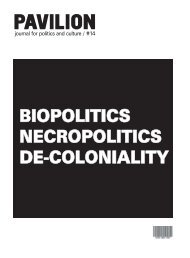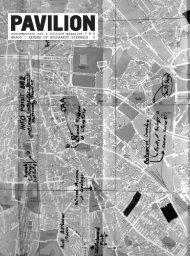Download pdf version of issue no. 16 (4 Mb) - Pavilion
Download pdf version of issue no. 16 (4 Mb) - Pavilion
Download pdf version of issue no. 16 (4 Mb) - Pavilion
Create successful ePaper yourself
Turn your PDF publications into a flip-book with our unique Google optimized e-Paper software.
positions overlap and intertwine with<br />
each other. Institutional critique can only<br />
have a relevant impact on society as a<br />
whole, if the agents <strong>of</strong> institutional critique<br />
are aware that their questions are<br />
formulated from a certain institutional<br />
platform.<br />
However, a more complex approach<br />
would suggest that the different strands<br />
<strong>of</strong> institutional critique can be brought<br />
together under a common de<strong>no</strong>minator.<br />
Self-consciousness embodies a certain<br />
intrinsic ‘otherness’ within itself, in that<br />
the self is conscious <strong>of</strong> what is other than<br />
itself. Self-consciousness on the part <strong>of</strong><br />
institutional critique is contradictory,<br />
because it is conscious <strong>of</strong> both sameness<br />
and otherness. The contradictions <strong>of</strong> governmentality,<br />
self-governance and selforganisation,<br />
to name but a few examples.<br />
The fundamental challenge <strong>of</strong> each<br />
form <strong>of</strong> government is how to govern, but<br />
<strong>no</strong>t too much, or, as Michel Foucault<br />
famously put it: ‘The suspicion that one<br />
always risks governing too much is<br />
inhabited by the question: Why, in fact<br />
one must govern?...In other words, what<br />
makes it necessary for there to be a government,<br />
and what ends should it pursue<br />
with regard to society in order to justify its<br />
existence?’[4] The ‘art <strong>of</strong> government’, for<br />
Foucault, is actually something that does<br />
<strong>no</strong>t entail any universalised distinction<br />
between different governing systems.<br />
‘Instead <strong>of</strong> making the distinction<br />
between state and civil society into a historical<br />
universal that allows us to examine<br />
all the concrete systems, we can try to<br />
see it as a form <strong>of</strong> schematization characteristic<br />
<strong>of</strong> a particular tech<strong>no</strong>logy <strong>of</strong> government.’<br />
[5]<br />
According to Gerald Raunig, ‘<strong>no</strong>t only<br />
[36]<br />
resistive individuals, but also progressive<br />
institutions and civil society NGOs operate<br />
on the same plane <strong>of</strong> governmentality.’<br />
[6] The main attribute <strong>of</strong> parrhesia<br />
(‘frankness’, ‘freedom <strong>of</strong> speech’) is <strong>no</strong>t<br />
the possession <strong>of</strong> truth, which is made<br />
public in a certain situation, but the taking<br />
<strong>of</strong> a risk, the ‘fact that a speaker says<br />
something dangerous - something other<br />
than what the majority believes.’[7]<br />
Raunig actually refers to Foucault’s statement<br />
that distinguishes between the<br />
‘classical Greek conception <strong>of</strong> parrhesia’<br />
– constituted by those who dare ‘to tell<br />
the truth to other people’ - and a new truth<br />
game, which entails being ‘courageous<br />
e<strong>no</strong>ugh to disclose the truth about oneself.’<br />
[8]<br />
The activity <strong>of</strong> speaking the truth is much<br />
more important than setting up truth in<br />
opposition to a lie, or to something ‘false’.<br />
Criticism, and especially institutional critique,<br />
is <strong>no</strong>t limited to de<strong>no</strong>uncing abuses,<br />
or to withdrawing into a more or less<br />
radical from <strong>of</strong> self-questioning. In the<br />
field <strong>of</strong> the visual arts, this means that<br />
neither the belligerent strategies <strong>of</strong> institutional<br />
critique <strong>of</strong> the 1970s <strong>no</strong>r the<br />
<strong>no</strong>tion <strong>of</strong> art as a service to the institution<br />
from the 1990s <strong>of</strong>fer any guarantee <strong>of</strong> the<br />
potential for intervening effectively in the<br />
governmentality <strong>of</strong> the present. [9]<br />
According to Raunig, a productive game<br />
emerges from the relationship between<br />
activists and the institution, so that social<br />
criticism and institutional critique permeate<br />
the interwoven strands <strong>of</strong> forms <strong>of</strong><br />
political and personal parrhesia. It is only<br />
by linking the two techniques <strong>of</strong> parrhesia<br />
that one-sided instrumentalisation can be<br />
avoided, the institutional machine is<br />
saved from closing itself <strong>of</strong>f, and the<br />
dynamic exchange between movement<br />
and institution can be maintained.<br />
In addition to Raunig’s proposal for applying<br />
parrhesia as a double strategy (as an<br />
attempt to engage in a process <strong>of</strong> refutation<br />
and self-questioning), I would suggest<br />
that dialogical critique <strong>of</strong>fers a more<br />
appropriate model <strong>of</strong> institutional critique,<br />
in terms <strong>of</strong> a positive agency <strong>of</strong> action. I<br />
suggest that a kind <strong>of</strong> deconstruction <strong>of</strong><br />
the one-way critique inherited from the<br />
models <strong>of</strong> institutional critique from the<br />
1970s and 1990s would engender a collaborative<br />
policy that could engage both<br />
state and independent institutions in the<br />
same critical projects, and favour the<br />
development <strong>of</strong> institutional awareness,<br />
though promoting a critical, yet constructive<br />
form <strong>of</strong> institutional activity.<br />
Instead <strong>of</strong> assuming that an institution<br />
has internalised power through the instruments<br />
<strong>of</strong> governance only because it is<br />
an institution with a higher position in the<br />
hierarchy, perhaps it would be more constructive<br />
to remember that the institutions<br />
<strong>of</strong> power are all around us, and that<br />
biopolitics reaches much further than<br />
only within its own institution.<br />
Ack<strong>no</strong>wledging this complex entanglement<br />
<strong>of</strong> power, its institutions, and its critique,<br />
could bring us closer to a sober,<br />
more refined, critical position that would<br />
be responsive to today’s forms <strong>of</strong> institutional<br />
critique. Different institutions could<br />
then contribute, both by embracing a selfcritical<br />
approach and by critiquing each<br />
others’ practices.<br />
Institutional Critique, as the<br />
Internalisation <strong>of</strong> Power and Politics<br />
The internalisation <strong>of</strong> institutional critique<br />
is a two way street:<br />
On the one hand, institutions very quickly<br />
internalise the critique aimed at them, by<br />
appropriating the same vocabulary as<br />
their critics and superficially incorporating<br />
the new structures. Institutions criticised<br />
in this way are strengthened in the<br />
process, even if they continue to work<br />
under the same rules as before: an institution<br />
constructs itself only after being<br />
interpellated by the right kind <strong>of</strong> critical<br />
opposition!<br />
On the other hand, critics themselves<br />
internalise institutional power, by practising<br />
the same forms <strong>of</strong> self-criticism time<br />
and time again, to the point where this<br />
starts to govern their own activities. By<br />
continuing to use the same methods,<br />
under the pretext <strong>of</strong> receiving protection<br />
from more powerful institutions, they thus<br />
become the gate-keepers and agents <strong>of</strong><br />
a form <strong>of</strong> negation that itself amounts to<br />
the exercise <strong>of</strong> power, <strong>of</strong> a different kind.<br />
In particular, the shift in institutional critique<br />
can best be discussed, by taking<br />
into consideration the shift in the role <strong>of</strong><br />
contemporary art museums in South-<br />
East Europe and the challenge to their<br />
mo<strong>no</strong>polistic position on the regional art<br />
scene, posed both by individuals and by<br />
the emergence <strong>of</strong> independently run,<br />
<strong>no</strong>n-governmental, art spaces. These<br />
changes have mainly occurred, because<br />
<strong>of</strong> the new critical curatorial practices that<br />
started as far back as the early 1990s<br />
and have been carefully nurtured by<br />
small, but very active, art institutions.<br />
It is important to stress the fact that, in the<br />
beginning, most <strong>of</strong> these new initiatives -<br />
especially, the appearance <strong>of</strong> the Soros<br />
[37]








